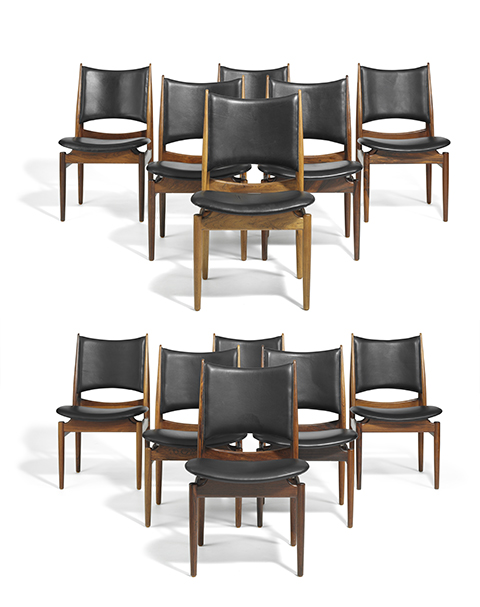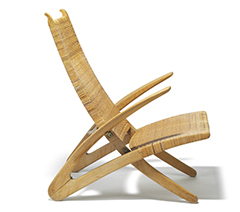The Icons of Finn Juhl and Hans J. Wegner’s Dolphin
At Bruun Rasmussen, we began 2019 on the lookout for modern furniture art for this year’s first Live Auction with Nordic design. Therefore, we can now present a broad array of icons, classics and rarities from the golden age of Danish design history.
Finn Juhl’s Thoughts on Functionalism
The architect Finn Juhl is a quintessential part of Danish design history. He stood out among other furniture designers with his artistic ambition and expressed opposition to a narrow understanding of the period’s ideas about functionality: ”Functionalism is an idiotic word, which merely alludes to certain geometrical relationships of surfaces and lines. It does not cover the ambition of Modernity in achieving the right form.” For Juhl, functionality could not stand on its own, and the excellent craftsmanship and sculptural forms became the guiding principle of his work. He displayed a great degree of open-mindedness in his designs and turned his attention towards both modern art and history – to places such as ancient Egypt.
Egyptian Interpretations
In 1923, the enigmatic Pharaoh Tutankhamun’s chamber tomb was opened in Egypt. His final resting place was enormous and contained furniture and precious art treasures from around 1300 BC. The discovery not only became the largest archaeological find in history up to that point – it also became a source of inspiration to a wealth of artists and furniture designers around the world. This was also the case in Denmark, where the architects of Modernism interpreted ancient Egyptian furniture. At the auction, we can present a set of 12 of Finn Juhl's rare "Egyptian Chair”, which, as the name suggests, is a historical reinterpretation: "To be honest, I have stolen the structure (...). I also have to admit that I have been and am becoming more enchanted by the simplest and most elegant furniture from Egypt than by other furniture pieces of the past”. Juhl designed the chair in 1949, and the offered set is made in the coveted wooden material of Brazilian rosewood.
Biblical References
The chairs have been in the ownership of the same family since 1969 together with Juhl's large dining table, known as the "Judas table". The table was also designed in 1949 and manufactured by Juhl's collaborator, the cabinetmaker Niels Vodder. The two furniture pieces complement each other so well that many perceive them as a set. The table is also an expression of a classical reference – this time to the Bible and the story of Judas, who received 30 silver coins for betraying Jesus. Spread out over the table top, 30 coin-like silver inlays are inserted in a geometric pattern that serves as a guide on how to set the table depending on the number of guests. A fun anecdote says that in the 1950s it was a costly affair to buy silver for the tables, and therefore Niels Vodder instead used ordinary Swedish coins, which at the time were still made of silver.
Wegner’s Diving Dolphin
Another of Danish design history's big names is Hans J. Wegner. In his furniture one can also find references, in particular to the animal kingdom. This time we offer one of his most refined furniture pieces in the shape of the rare short version of the "Dolphin Chair” from 1950, which we have only had under the hammer twice before. In a very elegant design, the armrests of the chair together with the hind legs form the outline of a diving dolphin. On several occasions, Wegner stated that "one cannot make something that is complete". For him, the perfect piece of furniture was an impossible dream, and this mindset was reflected in his special work method. Many of his furniture pieces served as archetypes, which were further developed in later versions. In 1946, he made his first folding furniture piece as an entry in an architectural competition called ”Møbler til mandens værelse” (furniture for the gentleman's room), and the “Dolphin Chair” here is, therefore, the result of a long line of "folding furniture".
Auction: Thursday 7 March at 2 pm CET at Bredgade 33 in Copenhagen
Preview: 21-25 February at the same address
View all the lots from the design auction
Read more about the auction
For further information, please contact:
Peter Kjelgaard: +45 8818 1191 · pkj@bruun-rasmussen.dk
Ole Ravn: +45 8818 1192 · olr@bruun-rasmussen.dk
Amalie Hansen: +45 8818 1194 · amh@bruun-rasmussen.dk
Anna Berger Widenborg: +45 8818 1187 · awi@bruun-rasmussen.dk
Andreas Krabbe: +45 8818 1193 · ank@bruun-rasmussen.dk
Poul Svalgaard Henriksen: +45 8818 1132 · psh@bruun-rasmussen.dk



